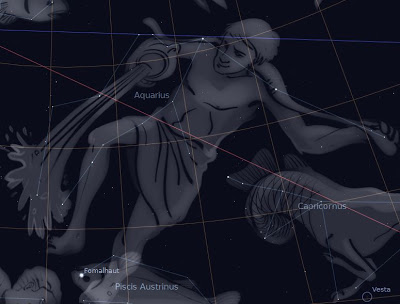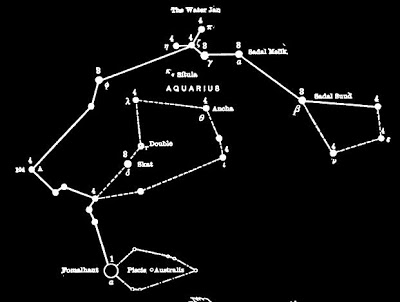While by the Horse's head the Water-Pourer
Spreads his right hand.
Aratus
The
astronomers of all nations, with the exception of the Arabians, have
adopted the figure of a man pouring water from a jar or pitcher to
express this constellation. The Arabs, being forbidden by law to draw
the 'human figure, have represented this sign by a saddled mule carry
ing on his back two barrels of water, and sometimes by only a water
bucket. They called the constellation "Al- Dawl," the "Well Bucket," and
not the "Water Bearer." For some reason, all the ancients imagined that
the part of the sky occupied by the Water Bearer and neighbouring
constellations contained a great celestial sea. Here we find the Whale,
the Pishes, the Dolphin, the Southern Fish, the Sea Goat, the Crane, (a
wading bird), and even Eridanus, the River Po, is sometimes shown as
having its source in the Waterman's Bucket. It also seems appropriate
that Pegasus is situated in this region of the sky, for the winged horse
was the Phoenician emblem of navigation, and the star Markab, as Alpha
Pegasi was called by the Arabs, signifies a ship or vehicle. According
to Ideler, the reason for this designation of " the Sea" for this region
of the heavens is because the sun passes through this part of the sky
during the rainy season of the year.
An Egyptian
legend averred that the floods of the Nile were caused by the Water
Bearer sinking his huge urn into the fountains of the river to refill
it, and accordingly this constellation represented to the Egyptians the
rainy period of the winter season. However, the Egyptians were probably
indebted to some other people for their knowledge of this constellation,
for Egypt
According
to Norse mythology, Aquarius was considered Wall's palace, and it was
supposed to be covered with silver. In the Indian zodiac, the name of
the constellation is "Kumbha," meaning "Water Jar." Allen states that
Kumbha is from xopfh), or Storm-god. Here again we find the
constellation associated with rain and tempest. Brown tells us that
Aquarius in the Hebrew zodiac represented the tribe of Reuben, "unstable
as water." In Greek mythology, Aquarius represented Ganymede, the
cup-bearer of the gods. Ganymede was a beautiful youth of Phrygia , and the son of Tros, King of Troy. He was taken up to heaven by Jupiter as he was tending his father's flocks on Mt. Ida
In
a Roman zodiac, Aquarius was represented by a pea-cock, the symbol of
Juno, the Greek Here, in whose month Gamelion (Jan.- Feb.) the sun was
in this sign. Aquarius has also been represented as a goose, another
bird sacred to the goddess. In February, the Aquarius month, the sun
entered the Peruvian sign known by the name "Mother of Waters" and "Eagle Bridge Andes , and the
rivers are then in flood so that the powers of the Mother of Waters are
at this season most conspicuously displayed. Allen states that the New
Testament Christians of the 16th and 17th centuries appropriately
likened Aquarius to John the Baptist and to Judas Thaddaeus the Apostle.
In Babylonia this constellation was
associated with the 11th month (Jan.-Feb.), called "Shabatu," meaning
"the Curse of Rain," and the Epic of Creation has an aceount of the
Deluge in its 11th book, corresponding to this the 11th constellation,
each of its other books numerically coinciding with the other zodiacal
signs. In that country an urn seems to have been known as "Gu," meaning a
water-jar overflowing. Plunket tells" us that "Gu" is possibly an
abbreviation of "Gula," the name of a goddess. This goddess under
another name was a personification of the dark water or chaos, hence the
identification of the goddess Gula with the constellation Aquarius. In
the cuneiform inscriptions of western Asia
we read: "The planet Jupiter in the asterism of the Urn lingers."
Considering the imagined aqueous nature of this region of the sky it is
not difficult, as Plunket says, to understand how the Vedic Rishis, who
appear to have combined the characteristics of poets, scientists, and
observers of the heavens, should have in 3000 B.C., when the sun was in
conjunction with Aquarius at the time of the winter solstice, have
described the fire of the solstitial sun as "hiding in, being born in,
and rising out of the celestial waters of the constellation Aquarius."
Some suppose Aquarius represents Deucalion, who was placed among the
stars after the celebrated deluge of Thessaly
in 1500 B.C., and the creation legend connected with this constellation
identifies it with the Flood. It may be that Noah, desiring to
perpetuate the record of the Deluge, found in the scroll of night a
parchment that never fades, and in the stars characters that time cannot
efface. Aquarius has also been identified with Cecrops, the Egyptian
who journeyed to Greece and founded Athens Tartary , Russia , Denmark , Lower Sweden, Westphalia , Hamburg , and Bremen
The
astronomical symbol of the sign representing undulating lines of waves,
is said to have been the hiero- glyph for water. The faint stars that
seem to trail southward from the water- jar are many of them in pairs
and triples, thus bearing out a stellar resemblance to a flowing stream.
In this region of the sky the 25th Hindu lunar station was situated.
The Hindu name for it signified "having a hundred physicians," and it
included a hundred stars, brightest being LambdaAquarii. The regent of
the asterism was Varuna, the god of the waters. The Arab lunar station
or manzil known as "the felicity of tents" was also located in this
region of the heavens, and the early Christians saw in this
constellation the figure of St. Jude. Aquarius, in spite of the
importance attached to it by the ancients, is an inconspicuous
constellation. It is characterised by a "Y "-shaped figure representing
the water- jar, composed of the stars Gamma, Zeta, Eta, Ki Aquarii. This
figure was called Situla or Urna by the Latins. A rough map of South America and a rude dipper are also to be traced out in the stars of this constellation.
Alpha Aquarii
is but one degree south of the celestial equator. It was called
"Sadalmelik" by the Arabs, which means "the fortunate star of the king."
This star marks the Chinese lunar station or Sieu, which they knew as
"GoeL" The star Beta Aquarii was called by the Arabs "Sadal Sud," "the
luckiest of the lucky," a title supposed to refer to the good fortune
attending the passing of winter. This star and Xi Aquarii constituted
the Persian lunar station known as "Bunda." On the Euphrates Beta
Aquarii was known as the "star of mighty destiny." The star Delta
Aquarii marks the radiant point of the meteors known as the Delta
Aquarids which appear from the 27th to the 29th of July, and in this
vicinity Mayer, in 1756, noted as a fixed star the object that was later
identified by Sir William Herschel as the planet Uranus.
Source: ”Star lore of all ages; a collection of myths, legends, and facts concerning the constellations of the Northern Hemisphere”, 1911 by Olcott, William Tyler
If
you are interested in learning more about the ancient science of the
sky, its origin, meaning and its practical use in measuring time cycles
with its application to stocks and commodity trading you may want to
read my book "Wall Street Watchman":



